SEO
Everything You Need To Know
Of all the many, many functions available in Google Ads, I have a few that are my favorites. And sitelink assets – previously known as sitelink extensions – are at the top of my list.
Why? Because they’re so versatile. You can do almost anything with them if you think through your strategy carefully.
For example, you can use the mighty sitelink in your advertising to:
- Promote low search volume themes.
- Push lagging products out the door.
- Maximize hot sellers.
- Highlight certain product categories.
- Answer common questions.
- Handle PR problems.
And that’s just a start! Sitelink assets can almost do it all.
Best Practices For Using Sitelink Assets Extensions
If you truly want to get the most out of your sitelinks, you need to think about your intention.
To help you with that, I’m going to lay out a few sitelink guidelines.
1. Get clear on your objectives. Before you start, you need to think about your goals. What are you trying to achieve with these assets? Are you advertising products or services? Will the asset work well with both branded and non-branded keywords? Your answers to these questions will help determine if your sitelinks are versatile and useful to the searcher.
2. Use sitelinks as part of your larger strategy. Don’t think of your sitelinks in isolation. You should also consider the accompanying ad, landing page, and other assets. Make sure they all work together in service to your overarching strategy.
3. Use a mix of sitelinks. Sitelinks can serve multiple purposes, so make sure you’re using a variety. For example, you don’t want to use every sitelink on an ad to promote on-sale products. Instead, use a mix. One could promote an on-sale product, one could generate leads, one could highlight a new product category, and one could direct prospective clients to useful information.
4. Create landing pages for your sitelinks. Ideally, you want to send users to landing pages that tightly correlate with your sitelink instead of just a regular page on your website.
5. Track sitelink performance and adjust. It’s not enough to set up sitelinks. You should also track them to see which links are getting traction and which ones are not. This doesn’t mean that all sitelinks should perform equally (more on this below), but it does mean they should perform well given their type and objectives.
Why it’s Better To Use A Mix Of Sitelink Assets
Let’s dive deeper into this idea of using a mix of sitelinks by looking at an example.
In a new client account, we created four different types of sitelinks:
- Two sitelinks are product-focused (as requested by the client).
- One sitelink connects users with an engineer to learn more about the product (“Speak to an Engineer”). It has more of a sales focus.
- One sitelink allows users to learn more about the products without speaking to an engineer (“What is?”).
The “What is?” sitelink is outperforming the “Speak to an Engineer” sitelink when we measure by CTR. While we need more data before making any changes, I predict we’ll eventually swap out the sales-y “Speak to an Engineer” sitelink for something else.
The fact that the educational link (“What is?”) is performing better than the sales-y link (“Speak to an Engineer”) isn’t too surprising in this case. The product is a new, cutting-edge robot that not many people are aware of, yet. They want more info before talking to someone.
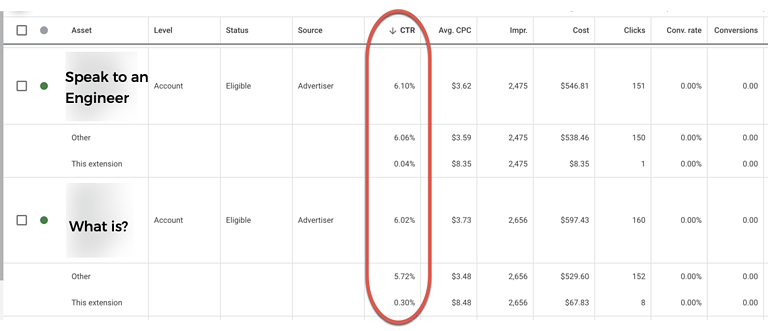 Screenshot by author, January 2023
Screenshot by author, January 2023By using a mix of sitelinks, and assessing the performance of each, we gained a lot of valuable information that is helping to guide our strategy for this account. So going with a mix of sitelinks is always a good idea. You never know what you’ll discover!
Sitelink Assets Examples
Now, let’s look at some specific examples of sitelink assets in Google Ads.
Example 1: Chromatography
 Screenshot from Google, January 2023
Screenshot from Google, January 2023Application Search: This ad is for a highly technical product that can be used in a wide variety of applications. (Chromatography is a laboratory technique for separating mixtures.) So putting “application search” in a sitelink here might make sense. It helps prospective clients find what they’re looking for.
Sign up and Save Big: A good sitelink for lead generation and potential revenue.
Technical Support: I’m not a big fan of putting technical support in sitelinks. Tech support seems more targeted to current users rather than prospective users. But who knows, maybe they really do want to help current users get tech support via their advertising.
Guides and Posters: Again, this sitelink is a bit unusual, but it might be appropriate for this product. Perhaps people are downloading branded posters and posting them in their workplaces. If so, it’s a great way to build brand awareness.
Example 2: Neuroscience Courses
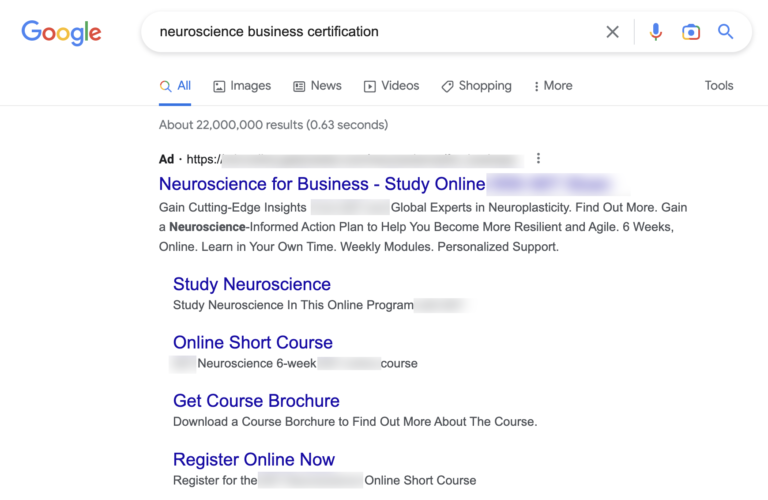 Screenshot from Google, January 2023
Screenshot from Google, January 2023I love everything about these sitelinks! The advertising is using them to reach people in all phases of the buyer journey.
For people not ready to commit:
- Study Neuroscience: This sitelink is broad and informational. It’s helpful to people who have just started to explore their options for studying neuroscience.
- Get Course Brochure: This sitelink is also great for people in the research phase. And while we mostly live in an online world, some people still prefer to consume hard-copy books, brochures, etc. With this sitelink, the school is covering its bases.
For people getting close to committing:
- Online Short Course: This is the course the school offers. It’s a great sitelink for those almost ready to sign up.
For people ready to sign up:
- Register Online Now: This is the strongest call to action for those ready to commit. It takes people directly to the signup page.
Example 3: Neuroscience Degrees
Let’s look at another example from the world of neuroscience education: this time for a neuroscience degree program.
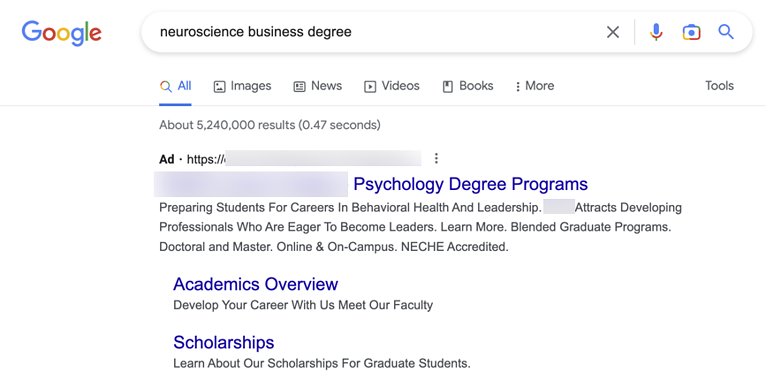 Screenshot from Google, January 2023
Screenshot from Google, January 2023In contrast to the previous two examples, the sitelinks in this ad aren’t as strong.
Academics Overview: This sitelink seems more appropriate for a broad term search, such as a search on the school’s name. If the searcher is looking for a specific degree program (which seems like the intention based on the term and the ad), the sitelinks should be something specific to that particular degree program.
Scholarships: Just as with the above sitelink, “Scholarships” doesn’t seem very helpful either. The topic of scholarships is important—but probably doesn’t need to be addressed until the person determines that this school is a good fit.
Example 4: Code Security
Next, let’s look at two Google search ads for code security products.
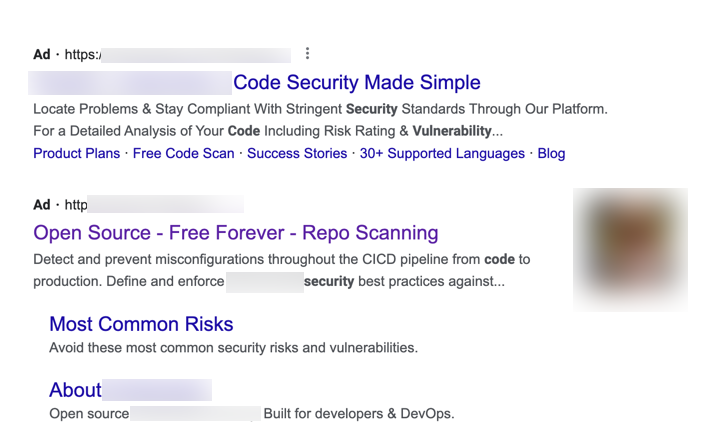 Screenshot from Google, January 2023
Screenshot from Google, January 2023
The sitelinks in these two ads look like typical assets you’d find for SaaS, cloud-based, or tech companies. They click through to a lot of helpful information, such as product plans and success stories.
I particularly like the Most Common Risks sitelink in the second ad. It leads to a helpful article that would be great for engaging top-of-funnel leads.
On the flip side, I’m not a big fan of the Blog sitelink in the first ad. “Blog” simply isn’t very descriptive or helpful.
Still, there are no right or wrong sitelinks here. And it would be interesting to test my theory that blog content is not a top-performing asset!
Sitelink Assets Are More Than An Afterthought
I hope I’ve convinced you of the usefulness and versatility of sitelinks when created with specific objectives that align with your broader strategy.
So don’t create your sitelink assets as an afterthought.
Because if you give them the careful consideration they deserve, they’ll serve you well.
Note: Google sitelink assets were previously known as sitelink extensions and renamed in September 2022.
More resources:
Featured Image: Thaspol Sangsee/Shutterstock
SEO
Google Rolls Out New ‘Web’ Filter For Search Results

Google is introducing a filter that allows you to view only text-based webpages in search results.
The “Web” filter, rolling out globally over the next two days, addresses demand from searchers who prefer a stripped-down, simplified view of search results.
Danny Sullivan, Google’s Search Liaison, states in an announcement:
“We’ve added this after hearing from some that there are times when they’d prefer to just see links to web pages in their search results, such as if they’re looking for longer-form text documents, using a device with limited internet access, or those who just prefer text-based results shown separately from search features.”
We’ve added this after hearing from some that there are times when they’d prefer to just see links to web pages in their search results, such as if they’re looking for longer-form text documents, using a device with limited internet access, or those who just prefer text-based…
— Google SearchLiaison (@searchliaison) May 14, 2024
The new functionality is a throwback to when search results were more straightforward. Now, they often combine rich media like images, videos, and shopping ads alongside the traditional list of web links.
How It Works
On mobile devices, the “Web” filter will be displayed alongside other filter options like “Images” and “News.”
If Google’s systems don’t automatically surface it based on the search query, desktop users may need to select “More” to access it.
 Screenshot from: twitter.com/GoogleSearchLiaison, May 2024.
Screenshot from: twitter.com/GoogleSearchLiaison, May 2024.More About Google Search Filters
Google’s search filters allow you to narrow results by type. The options displayed are dynamically generated based on your search query and what Google’s systems determine could be most relevant.
The “All Filters” option provides access to filters that are not shown automatically.
Alongside filters, Google also displays “Topics” – suggested related terms that can further refine or expand a user’s original query into new areas of exploration.
For more about Google’s search filters, see its official help page.
Featured Image: egaranugrah/Shutterstock
SEO
Why Google Can’t Tell You About Every Ranking Drop

In a recent Twitter exchange, Google’s Search Liaison, Danny Sullivan, provided insight into how the search engine handles algorithmic spam actions and ranking drops.
The discussion was sparked by a website owner’s complaint about a significant traffic loss and the inability to request a manual review.
Sullivan clarified that a site could be affected by an algorithmic spam action or simply not ranking well due to other factors.
He emphasized that many sites experiencing ranking drops mistakenly attribute it to an algorithmic spam action when that may not be the case.
“I’ve looked at many sites where people have complained about losing rankings and decide they have a algorithmic spam action against them, but they don’t. “
Sullivan’s full statement will help you understand Google’s transparency challenges.
Additionally, he explains why the desire for manual review to override automated rankings may be misguided.
Two different things. A site could have an algorithmic spam action. A site could be not ranking well because other systems that *are not about spam* just don’t see it as helpful.
I’ve looked at many sites where people have complained about losing rankings and decide they have a…
— Google SearchLiaison (@searchliaison) May 13, 2024
Challenges In Transparency & Manual Intervention
Sullivan acknowledged the idea of providing more transparency in Search Console, potentially notifying site owners of algorithmic actions similar to manual actions.
However, he highlighted two key challenges:
- Revealing algorithmic spam indicators could allow bad actors to game the system.
- Algorithmic actions are not site-specific and cannot be manually lifted.
Sullivan expressed sympathy for the frustration of not knowing the cause of a traffic drop and the inability to communicate with someone about it.
However, he cautioned against the desire for a manual intervention to override the automated systems’ rankings.
Sullivan states:
“…you don’t really want to think “Oh, I just wish I had a manual action, that would be so much easier.” You really don’t want your individual site coming the attention of our spam analysts. First, it’s not like manual actions are somehow instantly processed. Second, it’s just something we know about a site going forward, especially if it says it has change but hasn’t really.”
Determining Content Helpfulness & Reliability
Moving beyond spam, Sullivan discussed various systems that assess the helpfulness, usefulness, and reliability of individual content and sites.
He acknowledged that these systems are imperfect and some high-quality sites may not be recognized as well as they should be.
“Some of them ranking really well. But they’ve moved down a bit in small positions enough that the traffic drop is notable. They assume they have fundamental issues but don’t, really — which is why we added a whole section about this to our debugging traffic drops page.”
Sullivan revealed ongoing discussions about providing more indicators in Search Console to help creators understand their content’s performance.
“Another thing I’ve been discussing, and I’m not alone in this, is could we do more in Search Console to show some of these indicators. This is all challenging similar to all the stuff I said about spam, about how not wanting to let the systems get gamed, and also how there’s then no button we would push that’s like “actually more useful than our automated systems think — rank it better!” But maybe there’s a way we can find to share more, in a way that helps everyone and coupled with better guidance, would help creators.”
Advocacy For Small Publishers & Positive Progress
In response to a suggestion from Brandon Saltalamacchia, founder of RetroDodo, about manually reviewing “good” sites and providing guidance, Sullivan shared his thoughts on potential solutions.
He mentioned exploring ideas such as self-declaration through structured data for small publishers and learning from that information to make positive changes.
“I have some thoughts I’ve been exploring and proposing on what we might do with small publishers and self-declaring with structured data and how we might learn from that and use that in various ways. Which is getting way ahead of myself and the usual no promises but yes, I think and hope for ways to move ahead more positively.”
Sullivan said he can’t make promises or implement changes overnight, but he expressed hope for finding ways to move forward positively.
Featured Image: Tero Vesalainen/Shutterstock
SEO
56 Google Search Statistics to Bookmark for 2024

If you’re curious about the state of Google search in 2024, look no further.
Each year we pick, vet, and categorize a list of up-to-date statistics to give you insights from trusted sources on Google search trends.
- Google has a web index of “about 400 billion documents”. (The Capitol Forum)
- Google’s search index is over 100 million gigabytes in size. (Google)
- There are an estimated 3.5 billion searches on Google each day. (Internet Live Stats)
- 61.5% of desktop searches and 34.4% of mobile searches result in no clicks. (SparkToro)
- 15% of all Google searches have never been searched before. (Google)
- 94.74% of keywords get 10 monthly searches or fewer. (Ahrefs)
- The most searched keyword in the US and globally is “YouTube,” and youtube.com gets the most traffic from Google. (Ahrefs)
- 96.55% of all pages get zero search traffic from Google. (Ahrefs)
- 50-65% of all number-one spots are dominated by featured snippets. (Authority Hacker)
- Reddit is the most popular domain for product review queries. (Detailed)
- Google is the most used search engine in the world, with a mobile market share of 95.32% and a desktop market share of 81.95%. (Statista)


- Google.com generated 84.2 billion visits a month in 2023. (Statista)
- Google generated $307.4 billion in revenue in 2023. (Alphabet Investor Relations)
- 63.41% of all US web traffic referrals come from Google. (SparkToro)
- 92.96% of global traffic comes from Google Search, Google Images, and Google Maps. (SparkToro)
- Only 49% of Gen Z women use Google as their search engine. The rest use TikTok. (Search Engine Land)
- 58.67% of all website traffic worldwide comes from mobile phones. (Statista)
- 57% of local search queries are submitted using a mobile device or tablet. (ReviewTrackers)


- 51% of smartphone users have discovered a new company or product when conducting a search on their smartphones. (Think With Google)
- 54% of smartphone users search for business hours, and 53% search for directions to local stores. (Think With Google)
- 18% of local searches on smartphones lead to a purchase within a day vs. 7% of non-local searches. (Think With Google)
- 56% of in-store shoppers used their smartphones to shop or research items while they were in-store. (Think With Google)
- 60% of smartphone users have contacted a business directly using the search results (e.g., “click to call” option). (Think With Google)
- 63.6% of consumers say they are likely to check reviews on Google before visiting a business location. (ReviewTrackers)
- 88% of consumers would use a business that replies to all of its reviews. (BrightLocal)
- Customers are 2.7 times more likely to consider a business reputable if they find a complete Business Profile on Google Search and Maps. (Google)
- Customers are 70% more likely to visit and 50% more likely to consider purchasing from businesses with a complete Business Profile. (Google)
- 76% of people who search on their smartphones for something nearby visit a business within a day. (Think With Google)
- 28% of searches for something nearby result in a purchase. (Think With Google)
- Mobile searches for “store open near me” (such as, “grocery store open near me” have grown by over 250% in the last two years. (Think With Google)
- People use Google Lens for 12 billion visual searches a month. (Google)
- 50% of online shoppers say images helped them decide what to buy. (Think With Google)
- There are an estimated 136 billion indexed images on Google Image Search. (Photutorial)
- 15.8% of Google SERPs show images. (Moz)
- People click on 3D images almost 50% more than static ones. (Google)
- More than 800 million people use Google Discover monthly to stay updated on their interests. (Google)
- 46% of Google Discover URLs are news sites, 44% e-commerce, 7% entertainment, and 2% travel. (Search Engine Journal)
- Even though news sites accounted for under 50% of Google Discover URLs, they received 99% of Discover clicks. (Search Engine Journal)


- Most Google Discover URLs only receive traffic for three to four days, with most of that traffic occurring one to two days after publishing. (Search Engine Journal)
- The clickthrough rate (CTR) for Google Discover is 11%. (Search Engine Journal)
- 91.45% of search volumes in Google Ads Keyword Planner are overestimates. (Ahrefs)
- For every $1 a business spends on Google Ads, they receive $8 in profit through Google Search and Ads. (Google)
- Google removed 5.5 billion ads, suspended 12.7 million advertiser accounts, restricted over 6.9 billion ads, and restricted ads from showing up on 2.1 billion publisher pages in 2023. (Google)
- The average shopping click-through rate (CTR) across all industries is 0.86% for Google Ads. (Wordstream)
- The average shopping cost per click (CPC) across all industries is $0.66 for Google Ads. (Wordstream)
- The average shopping conversion rate (CVR) across all industries is 1.91% for Google Ads. (Wordstream)
- 58% of consumers ages 25-34 use voice search daily. (UpCity)
- 16% of people use voice search for local “near me” searches. (UpCity)
- 67% of consumers say they’re very likely to use voice search when seeking information. (UpCity)
- Active users of the Google Assistant grew 4X over the past year, as of 2019. (Think With Google)
- Google Assistant hit 1 billion app installs. (Android Police)
- AI-generated answers from SGE were available for 91% of entertainment queries but only 17% of healthcare queries. (Statista)
- The AI-generated answers in Google’s Search Generative Experience (SGE) do not match any links from the top 10 Google organic search results 93.8% of the time. (Search Engine Journal)
- Google displays a Search Generative element for 86.8% of all search queries. (Authoritas)


- 62% of generative links came from sources outside the top 10 ranking organic domains. Only 20.1% of generative URLs directly match an organic URL ranking on page one. (Authoritas)
- 70% of SEOs said that they were worried about the impact of SGE on organic search (Aira)
Learn more
Check out more resources on how Google works:
-

 PPC6 days ago
PPC6 days agoHow the TikTok Algorithm Works in 2024 (+9 Ways to Go Viral)
-

 SEO5 days ago
SEO5 days agoHow to Use Keywords for SEO: The Complete Beginner’s Guide
-

 MARKETING6 days ago
MARKETING6 days agoHow To Protect Your People and Brand
-

 MARKETING4 days ago
MARKETING4 days agoAdvertising on Hulu: Ad Formats, Examples & Tips
-

 MARKETING5 days ago
MARKETING5 days agoUpdates to data build service for better developer experiences
-

 MARKETING5 days ago
MARKETING5 days agoThe Ultimate Guide to Email Marketing
-
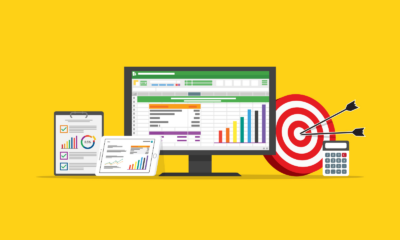
 SEO7 days ago
SEO7 days agoAutomate Multi-Site Reporting With Google Sheets And GSC API
-

 MARKETING22 hours ago
MARKETING22 hours ago18 Events and Conferences for Black Entrepreneurs in 2024




You must be logged in to post a comment Login